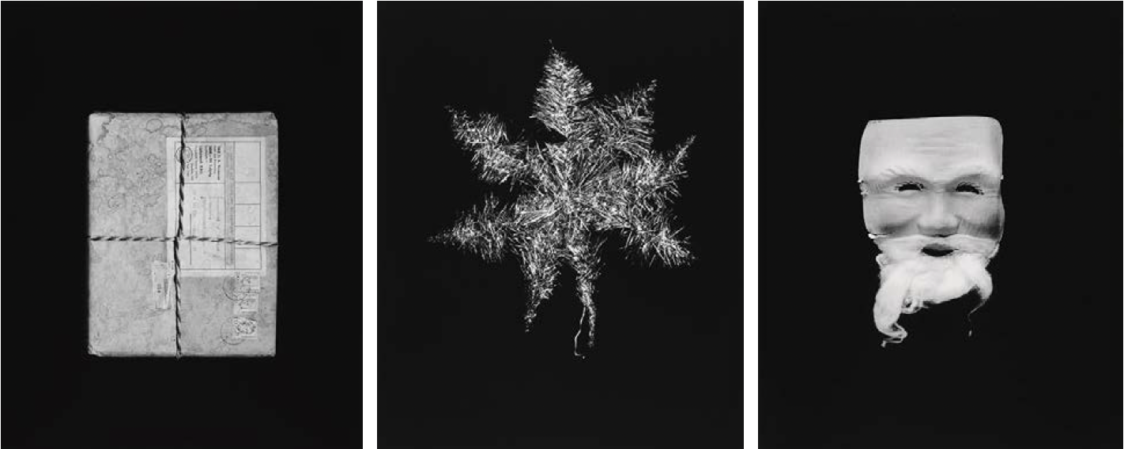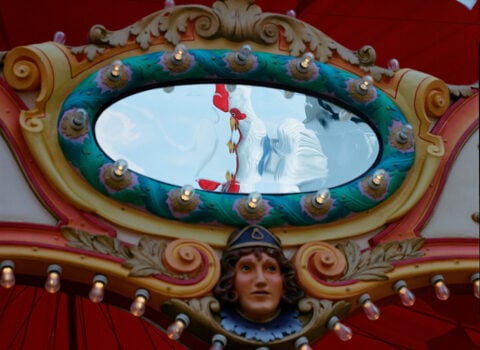
“Parcel,” “Christmas Tree Topper,” and “Father Christmas Mask,” photographs by Martti Jämsä from the Objets trouvés series. Jämsä’s work is on view at Photographic Gallery Hippolyte, in Helsinki. Courtesy the artist and Galleria Heino, Helsinki
Researchers using the global organology of von Hornbostel and Sachs tracked the extinction of aerophones in South America. A study of Roman tools at Volubilis found that grain millstones were made from vesicular basalt, olive mills from clastic fossiliferous limestone, and dough mixers from nonclastic limestone. The camel reliefs at the Camel Site were dated to the sixth millennium bc. The vast migrations of Bronze Age Eurasian pastoralists were enabled by the drinking of horse milk. Black layers in Antarctic ice cores were traced to Maori burning practices that constitute one of the largest known preindustrial anthropogenic releases of carbon, which caused phytoplankton blooms in the Southern Ocean similar to those that occurred after recent Australian wildfires.
Surgeons cured a man who was ejaculating out of his anus. Japanese researchers transported freeze-dried mouse sperm via postcard. Scientists injured mice and then massaged their legs with a robotic device, and found that a ketogenic diet in concert with hypoxia impairs the ability of mice to navigate mazes. Rats on LSD running on a familiar track appear to be half asleep and half awake. Having a sense of purpose makes memories more vivid and coherent, and motivated cognition can be socially contagious. Children begin to understand the nature of false belief between the ages of six and seven. The particular light falling on a pregnant belly can affect the psychiatric state of the fetus as an adult. The United Kingdom’s National Pig Association reported piglet culls amid the fallout from COVID-19 and Brexit. Surface water in eastern North Carolina is more likely to contain both human and swine feces than either in isolation. Human infant feces contains ten times the PET microplastic content of adult feces. The International Marine Litter Research Unit found that two-year-old marine ropes shed 720 fragments of microplastic per meter hauled. Researchers clarified that hermit crabs are excited by and attracted to plastic waste, but not sexually.
Helmholtz-Zentrum Hereon researchers produced a skillful ten-year cod forecast, ecologists found that the age of a lobster can be determined by its DNA, and paleontologists sought to determine why so few species of mackerel shark are alive today. A tanker arrived in Japan with a dead fin whale on its bow. Llama nanobodies may prevent COVID-19, and a coronavirus found in Laotian bats is much more closely related to SARS-CoV-2 than the coronavirus found among horseshoe bats in southern China. In the Namib Desert, three cheetahs who ate the same zebra died of anthrax. Yezo, a novel tick-borne virus discovered in Japan, was blamed for febrile illnesses in two hospital patients. China eliminated malaria. A man buried five thousand years ago on the banks of the Salaca River was determined to be the first known plague victim. The clouds of Venus may be hospitable to life. The nebula Pa30, surrounding Parker’s Star, is likely the Chinese Guest Star supernova observed by Chinese and Japanese astronomers in 1181 ad. Earthshine is diminishing.




